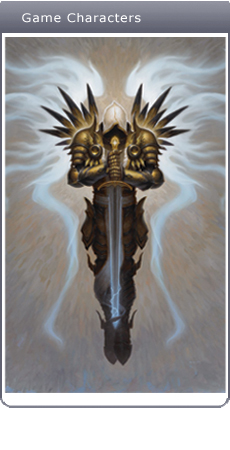 Home » Site News » WoW Introductory guide to f...
Home » Site News » WoW Introductory guide to f...
WoW Introductory guide to fighting hunters, Part 3
Tags : wow introductory guide, guide to fighting hunters, wow guide, wow news

Marksmanship
Where beast mastery might be considered a brute force spec, the marksmanship style of play might be considered finesse. Although they won't be as easy to spot as BM hunter, many marksmanship hunters will open with a Silencing Shot against a caster. Other hunters will use it at more opportune times, such as mid-cast, and keep it on stand-by to counter important spells (the shot doesn't trigger the Global Cooldown). Although note that it is a silence effect, so it doesn't take much timing to use, and most hunters will use it often just to prevent casters from getting anything through. All marksmanship hunters will have Aimed Shot, although it's high enough in the tree for other specs to pick up.
Play it safe by removing their stings as much as possible, although these will be harder to dispel thanks to Improved Stings. Marksmanship hunters have Chimera Shot, a shot that confers an additional effect when a sting is on a target, such as additional damage with Serpent Sting or a disarm effect with Scorpid Sting. Marksmanship PvP takes some time to build up and are better suited to long matches or encounters. In the Battlegrounds, bringing the fight to them and going on the offensive is a good strategy because marksmanship PvP is mostly about control. Marksmanship also has access to Readiness, which essentially gives them a reset button if things such as traps or Feign Death fails.
Marksmanship hunters have even fewer solutions to crowd control than BM hunters, who have Beast Within. Compared to the two other specs, marksmanship has relatively lower survivability so the best defense against them is a good offense. Keep the distance close or force them to keep moving to prevent them from establishing any sort of rhythm with their shots.
Survival
The survival tree used to be the red-headed stepchild of the hunter class, but changes in Wrath of the Lich King not only made it relevant but also made it the spec du jour in the expansion for both PvE and PvP. One thing that hasn't changed is that survival hunters are more capable in melee than the other two specs. PvP specs will have Scatter Shot (an ability many hunters will argue should be made baseline) to break from melee, higher resistance to snares, and a few even pick up Counterattack to root opponents, although those are rare. Most PvP-specced survival hunters will complement their talents with marksmanship all the way to Aimed Shot.
They are harder to identify although many will use Wyvern Sting to crowd control one enemy while attacking another. If you see Wyvern Sting on an ally, it's usually best to leave it to expire on its own because most survival hunters in PvP will have Noxious Stings. Survival hunters are at their best when weaving from close range to long range, using traps as often as possible to proc Lock and Load. It's bad news to trigger a survival hunter's Frost Trap as you'll be rooted and vulnerable to a barrage of Explosive Shots (with other shots in between!). They deal a lot of fire damage, so fire resistance of some sort wouldn't hurt.
Survival hunters benefit from traps in a way similar to how marksmanship hunters rely on stings. Survival hunters will get close, trap, and Disengage often. Fortunately, PvP and PvE talents in the survival tree are very distinct, and speccing for one often means losing out utility or efficiency in the other. Because most bosses in raids and instances are immune to traps, most trap-oriented talents will see use in PvP instead.
They have a lot of solutions for PvP such that keeping them at close range isn't always the best advice. The idea is to avoid triggering their traps, which counterintuitively means trying to stay away from melee range as they will often drop a trap when they're in close range to ensure it goes off. On the other hand, melee classes can defuse this by triggering traps but preventing them from capitalizing by keeping them under 8 yards. It's easier said than done when survival hunters can root with their traps. Also remember that the hunter gains Lock and Load no matter who triggers the trap. Overall, survival hunters tend to be the most versatile and, played well, most difficult spec to counter.
Paying attention
Hunters get away with a lot in the chaos of the Battlegrounds and world PvP. As opposed to the smaller, confined spaces of Arenas, hunters can very often get away with finding a good spot and firing away. Don't let them. Either maneuver to get to them or, barring that, move beyond 40 yards and find another approach. Hunters work well as support by chipping away at opponents while their melee allies get close. Other hunters such as marksmen will make it their task to take out the healers at the back.
While hunters won't necessarily be a priority target in these situations, allowing them to work unmolested can turn the tide of a battle. Because they often work some distance from the fray, keeping them crowd controlled is a good way to reduce their impact during a fight and there's a lesser chance an ally will accidentally break it. Hunters are a powerful offensive force but ultimately suffer from their limited options to escape CC and snares. Bait them into using all their options -- a hunter popping Deterrence is a desperate one -- and they should be easier to manage.
Source: wow.com
Fast Order
| USD EUR GBP AUD CAD | |
 | |

Shopping Cart
Contact us
Teams/Skype (sell to us) :selltoallen
Email: [email protected]
Discord:gameim#1112
Discord:Gaimugold#1567
Use of this Web site constitutes acceptance of the [ TERMS & CONDITIONS ] and [ PRIVACY POLICY ]
Copyright © 2007-2015, mmogarden Inc. All Rights Reserved.


